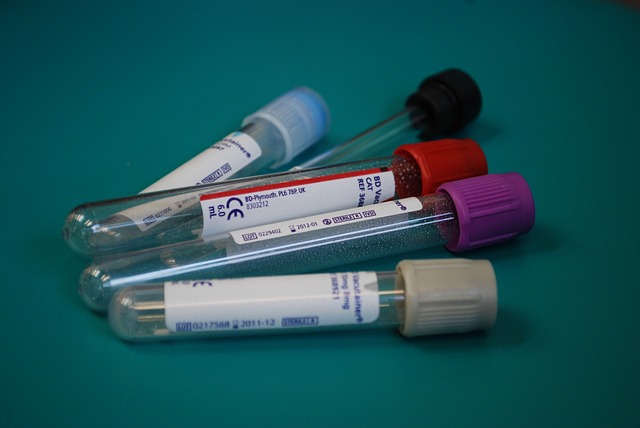Liver Function Tests (LFTs) are key to assessing liver health, with at-home blood tests in the UK offering a convenient way to monitor liver health discreetly. Early detection through these tests is vital for improved patient outcomes by enabling prompt intervention and specialist consultation. Performing a home blood test involves preparation, sterilisation techniques, safe venipuncture, labelling samples, and storing them appropriately. Key enzymes like ALT and AST signal potential liver issues; high levels may indicate viral hepatitis, medication side effects, or non-alcoholic fatty liver disease (NAFLD).
Liver function tests (LFTs) are essential tools for healthcare professionals, enabling them to assess liver health and diagnose potential issues. This comprehensive guide delves into the world of LFTs, providing a detailed look at what these tests measure and their significance in clinical practice. We also offer a step-by-step tutorial on performing a blood test at home specifically for UK healthcare professionals, empowering them with valuable skills for routine liver assessments. Understanding and interpreting results is crucial to identifying abnormal liver enzymes and implementing appropriate patient care strategies.
- Understanding Liver Function Tests: What They Measure and Why
- How to Perform a Blood Test at Home: A Step-by-Step Guide for Healthcare Professionals in the UK
- Interpreting Results: Knowing When Liver Enzymes Are Abnormal and Next Steps for Patient Care
Understanding Liver Function Tests: What They Measure and Why
Liver function tests (LFTs) are a series of blood tests that evaluate the health and performance of your liver. These tests are essential tools for medical professionals to assess liver damage, disease, or other conditions. LFTs measure various enzymes and proteins produced by the liver, which can indicate its overall functioning. Key metrics include alanine aminotransferase (ALT), aspartate aminotransferase (AST), alkaline phosphatase (ALP), gamma-glutamyl transferase (GGT), and bilirubin levels.
At-home blood tests for liver function have gained popularity in the UK, allowing individuals to monitor their liver health discreetly. These home testing kits provide an easy way to check for elevated liver enzymes or other indicators of liver issues without the need for frequent hospital visits. Early detection through LFTs is crucial as it enables prompt intervention and management of potential liver problems, ultimately improving patient outcomes.
How to Perform a Blood Test at Home: A Step-by-Step Guide for Healthcare Professionals in the UK
Performing a blood test at home can be a valuable skill for healthcare professionals in the UK, offering convenience and early detection of potential health issues. Here’s a step-by-step guide to ensure accurate results:
1. Preparation: Begin by explaining the procedure to the patient, ensuring their comfort and addressing any concerns. Gather all necessary tools: sterile blood collection kits, alcohol swabs, gloves, and a suitable surface for venipuncture. Double-check that the kit is suitable for home use and complies with UK regulations.
2. Sterilisation: Clean the patient’s skin around the vein with an alcohol swab to minimise contamination. Put on sterile gloves to prevent contact transmission. Locate a suitable vein, typically in the antecubital fossa (inside the elbow), and gently apply pressure to it for a few seconds to make it more prominent and easier to access.
3. Venipuncture: Using the blood collection kit, carefully insert the needle into the vein at an angle of approximately 45 degrees. Avoid inserting it too deeply to prevent damage to surrounding structures. Once the needle is in place, draw the required volume of blood as specified by the test request.
4. Handling Blood Samples: After collecting the sample, immediately apply gentle pressure to the puncture site with a sterile bandage or cotton wool. Let the patient know they may experience slight discomfort or bruising, which is normal. Label the sample clearly with the patient’s details and store it in a suitable container, following the guidelines for transport and storage provided by your healthcare institution.
Interpreting Results: Knowing When Liver Enzymes Are Abnormal and Next Steps for Patient Care
Liver function tests (LFTs) are a crucial part of any comprehensive blood test, offering valuable insights into liver health. When interpreting LFT results, medical professionals must pay close attention to specific enzymes and their abnormal levels. Elevations in liver enzymes, such as alanine aminotransferase (ALT) and aspartate aminotransferase (AST), are often an indicator of liver damage or inflammation. These enzymes leak into the bloodstream when liver cells are injured, making them valuable markers for detecting issues early on.
For instance, a blood test at home UK might reveal elevated ALT levels, suggesting potential hepatocyte damage. This could be caused by various factors, including viral hepatitis, medication-induced toxicity, or even non-alcoholic fatty liver disease (NAFLD). Knowing when liver enzymes are abnormal is vital for patient care. The next steps may include further investigations to identify the underlying cause, such as additional blood tests, imaging scans, or referring the patient to a specialist for further evaluation and tailored treatment.
Liver function tests (LFTs) are a vital tool for healthcare professionals in the UK, enabling them to assess liver health and identify potential issues. By following a structured approach to performing blood tests at home, as outlined in this article, medical practitioners can ensure accurate diagnoses and timely interventions. Understanding the significance of LFTs’ various enzymes and their interpretations is crucial for effective patient care, allowing healthcare providers to navigate complex liver-related conditions with confidence.
